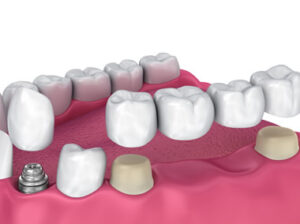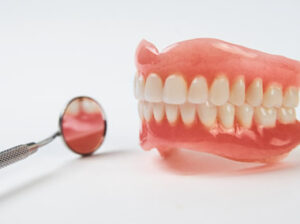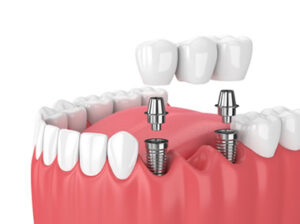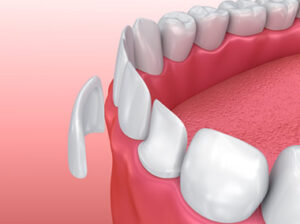What is Prosthesis?
In cases where the teeth and surrounding tissues have missing parts or are completely destroyed, that is when they are lost, due to various reasons, the prepared materials used to repair or replace them are called prostheses. Generally, it is divided into two as fixed and removable.
What Are Fixed Prostheses?


These are the prosthesis types used for fixing the losses on the teeth and allowing the patient to perceive them as their own teeth. Crowns used for covering missing parts on a single tooth and bridges used for covering missing teeth are called fixed prostheses.
- Crown: It is the process of minimizing and covering teeth with decay, fractures or excessive loss of material due to other reasons.
- Bridge: It is the process of minimizing neighboring teeth and filling the interdental spaces by getting support from the coatings special to them, when one or more teeth are missing.
What are Removable Prostheses?


These are the types of prostheses that are applied when the number of missing teeth cannot be compensated with a fixed prosthesis or when all the teeth in the jaw are missing.
Complete (total) prostheses: If all of the teeth in the person’s mouth are missing, a total prosthesis – full prosthesis must be made.
Partial prostheses: It is a type of prosthesis that provides attachment to the tooth with metal parts called crochet (hook) made with a combination of special acrylic and metals in partial tooth deficiency.
Precision attachment prostheses: It is another type of prosthesis used in partial tooth loss. The retention of the prosthesis is provided not by crochets like in partial prosthesis, but by female and male parts called precision connections. These prostheses are far superior to conventional partial prostheses in terms of aesthetics, retention and health.
What are Implant Overdentures?

- Crown: It is the procedure performed on a single implant placed in the jawbone without touching the neighboring teeth, when just a single tooth is missing.
- Bridge: It is the procedure performed on two or more implants placed in the jawbone without touching the neighboring teeth, when multiple teeth are missing.
- In Case of Total Edentation: Fixed or removable prostheses can be made on the implants placed in the mouth, depending on the number of implants made.
What is the Purpose of Prosthesis?
While trying to regain the lost functions of the patient, prosthesis aims at correcting the deteriorated speech and improving the aesthetic appearance. In this way, while the oral health lost to a large extent is improved, individuals who have to live with missing or destroyed teeth in the society are also psychologically supported.
What is Zirconium Tooth?


Dental veneers are mostly applied in the form of porcelain veneers. These are divided into two as metal supported and non-metal veneers. For patients who need a more aesthetic smile, dentists also have more aesthetic treatment approaches. These aesthetic needs bring forward the frequent use of zirconium-based teeth for treatment, which is a more aesthetic approach in dentistry.
Zirconium is a type of metal discovered in the 18th century. It is a type of metal preferred in many areas as its biggest feature is its resistance to corrosion. It is used as a substructure under ceramic crowns in dentistry because of its white color and its light transmittance.
Zirconium crown is an ideal type of dental treatment for patients with white color, heat resistance and allergy to metal. It is mostly preferred in front teeth due to its aesthetic and natural appearance.
What is Laminate Tooth Veneer?
It is the process of slightly abrading the front surface of the tooth and coating it with a fine porcelain. Since porcelain is prepared in a very thin layer, its light transmission and reflection is very close to the natural tooth and thanks to this feature, it provides excellent aesthetics. One of its most important advantages is that the teeth are not cut too much and, when an advanced treatment method is necessary, it allows the tooth to be completely cut and covered with porcelain.
In order to be used for a long time;
- Having good oral care,
- Avoiding biting hard foods with the front teeth,
- Using night plate if you have a habit of clenching or grinding your teeth,
- Giving up the habit of eating nails,
- Visiting your dentist every six months are required.
What Happens If Missing Teeth are not Replaced by Prosthesis?
When the missing teeth are not replaced with prosthesis, neighboring teeth and teeth in the opposite jaw move towards the extraction cavity. For this reason, the deteriorated tooth causes closure, decays and tooth loss. It causes more complex problems in the mouth.
How to Care for Prosthetics?
In addition to brushing their teeth twice a day and using dental floss, individuals using fixed prostheses should especially use special floss and interface brushes to clean the body parts that replace empty teeth for the maintenance of prostheses. If fixed prostheses are not properly cared for, problems such as gingival problems and bad breath will be inevitable.
Removable prostheses should be removed after meals and cleaned with plenty of water. For the health of the oral tissue, the prosthesis should be removed every night before going to bed. It is necessary to clean the food residues and plaque on the prostheses by using special brushes or soft-bristled toothbrushes produced for prostheses every day. Substances that have abrasive properties and that spoil the prosthetic polish should not be used. Soapy water or specially produced products should be preferred. Chemicals such as detergent and bleach should never be used while cleaning the prosthesis. When the prosthesis is not in the mouth, it must definitely be left in water.
Even if people using prosthesis do not have any complaints, it will be good to visit the dentist every six months and be checked in order to prevent future problems.
